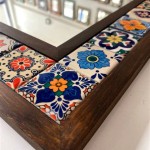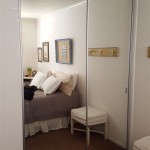How to Hang a Heavy Mirror on Plasterboard
Hanging a mirror can dramatically enhance a room, adding light and creating a sense of spaciousness. However, when dealing with a heavy mirror and plasterboard walls, the process requires careful planning and execution to ensure the mirror is securely and safely mounted. Plasterboard, also known as drywall or gypsum board, is a common wall material due to its ease of installation and relatively low cost. However, it's not inherently strong and can struggle to support significant weight without proper reinforcement or specialized hardware. Successfully hanging a heavy mirror involves understanding the limitations of plasterboard and choosing the appropriate hanging method.
The inherent challenge when hanging a heavy object on plasterboard stems from its composition. Plasterboard typically consists of a gypsum core sandwiched between two layers of paper. While the paper provides some tensile strength, the gypsum core is relatively soft and prone to crumbling if subjected to concentrated pressure or excessive weight. Therefore, relying solely on nails or screws directly into the plasterboard is unlikely to provide a secure and long-lasting hold for a heavy mirror. The mirror's weight will gradually stress the plasterboard, leading to potential failure and a risk of the mirror falling.
Before attempting to hang a heavy mirror, several preliminary steps are crucial. First, accurately assess the weight of the mirror. This information is essential for selecting the appropriate type and number of fixings. Next, thoroughly inspect the plasterboard wall. Look for any signs of damage, such as cracks, holes, or water stains, which could compromise its structural integrity. If damage is present, it should be repaired before proceeding with the hanging process. Finally, determine the desired location for the mirror, considering factors such as lighting, visual appeal, and accessibility.
Identifying Wall Studs
One of the most secure methods for hanging a heavy mirror on plasterboard is to anchor it to wall studs. Wall studs are vertical wooden or metal framing members that provide structural support for the wall. They are typically spaced 16 or 24 inches apart, center to center. Finding and utilizing these studs offers a significantly stronger anchor point than relying solely on the plasterboard.
Several methods can be used to locate wall studs. A stud finder is an electronic device that detects changes in density behind the wall surface, indicating the presence of a stud. These devices are readily available and relatively inexpensive. Another method involves tapping lightly on the wall. A solid sound generally indicates a stud, while a hollow sound suggests an empty space between studs. However, this method requires some experience and a good ear. Alternatively, look for outlets or switches on the wall. These are often attached to studs, and the stud is usually located on one side of the electrical box.
Once a stud is located, verify its position using a thin nail or screw. Drive the nail or screw through the plasterboard at the suspected stud location. If it encounters solid resistance, it's likely hitting a stud. If it goes through easily, it's likely missing the stud. Once the stud is confirmed, mark its location clearly with a pencil. If multiple studs are needed to support the mirror's hanging hardware, locate and mark each one accurately.
After identifying the studs, use appropriate screws to attach the mirror's hanging hardware directly to them. Choose screws that are long enough to penetrate the stud by at least one inch, ensuring a secure hold. Predrilling pilot holes can help prevent the wood from splitting and make it easier to drive the screws in straight. Ensure the hanging hardware is rated to support the weight of the mirror. This information is usually provided by the hardware manufacturer.
Using Plasterboard Anchors
If it's not possible to align the mirror's hanging hardware with wall studs, various types of plasterboard anchors can be used. These anchors are designed to provide a secure hold in plasterboard by expanding or gripping the material behind the wall surface. The specific type of anchor needed will depend on the weight of the mirror and the thickness of the plasterboard.
Toggle bolts are a type of anchor that provides a strong and reliable hold in plasterboard. They consist of a bolt and a wing-like toggle that folds flat to pass through a hole in the wall. Once inside the wall cavity, the toggle springs open, providing a large bearing surface that distributes the weight of the mirror over a wider area. To install a toggle bolt, drill a hole in the plasterboard that is large enough to accommodate the folded toggle. Insert the bolt through the mirror's hanging hardware and then attach the toggle to the bolt. Fold the toggle flat and insert it through the hole in the wall. Once the toggle is completely through the hole, pull the bolt towards you to allow the toggle to spring open. Tighten the bolt until the hanging hardware is securely attached to the wall. Avoid overtightening, as this can damage the plasterboard.
Molly bolts, also known as expansion bolts, are another type of anchor suitable for hanging heavy mirrors on plasterboard. They consist of a bolt and a sleeve that expands as the bolt is tightened. To install a molly bolt, drill a hole in the plasterboard that is slightly smaller than the diameter of the anchor. Insert the anchor through the mirror's hanging hardware and then insert it into the hole in the wall. Tighten the bolt until the sleeve expands and grips the plasterboard tightly. As with toggle bolts, avoid overtightening to prevent damage to the wall.
Self-drilling plasterboard anchors, also known as wall plugs or screw anchors, are a simpler option for lighter mirrors. These anchors are designed to be screwed directly into the plasterboard without pre-drilling a hole. They typically have a pointed tip that pierces the plasterboard and a threaded body that grips the material as it's screwed in. To install a self-drilling anchor, position it against the wall at the desired location and use a screwdriver or drill to screw it into the plasterboard. Once the anchor is fully inserted, attach the mirror's hanging hardware and secure it with a screw.
When selecting plasterboard anchors, carefully consider the weight rating. Choose anchors that are rated to support at least twice the weight of the mirror to provide a margin of safety. Also, be sure to use the correct size drill bit for the chosen anchor type. Using a drill bit that is too small will make it difficult to insert the anchor, while using a drill bit that is too large will result in a loose and insecure fit.
Additional Considerations for Heavy Mirrors
Beyond selecting the appropriate hanging method, several other factors contribute to the successful and safe installation of a heavy mirror on plasterboard. The hanging hardware itself plays a crucial role. D-rings, wire, and other hanging mechanisms should be strong and durable enough to support the mirror's weight. Avoid using flimsy or damaged hardware, as this can increase the risk of failure.
The spacing of the hanging hardware is also important. Distribute the weight of the mirror evenly by using multiple hanging points. For larger mirrors, consider using two or more hanging points along the top edge and possibly even along the bottom edge. This will help prevent the mirror from tilting or putting excessive stress on a single point.
When hanging a particularly heavy mirror, consider adding a supporting wire or chain that runs from the top of the mirror to a secure anchor point above. This will provide additional support and prevent the mirror from falling in case of anchor failure. The wire or chain should be strong enough to support the entire weight of the mirror.
Before fully committing to the hanging location, use a level to ensure the mirror is perfectly straight. Mark the desired position with a pencil and then double-check it with the level. Making small adjustments at this stage can prevent the need for more significant corrections later. Once the mirror is hung, periodically check the anchors and hanging hardware to ensure they are still secure. Tighten any loose screws or replace any damaged components.
Finally, if unsure about any aspect of the hanging process, it's always best to consult a professional. A qualified handyman or contractor can assess the situation, recommend the appropriate hanging method, and install the mirror safely and securely. This is particularly important for very heavy mirrors or when dealing with damaged or unstable plasterboard.
By carefully considering the weight of the mirror, the limitations of plasterboard, and the various hanging options available, individuals can successfully and safely hang heavy mirrors on plasterboard walls, enhancing the aesthetic appeal and functionality of their living spaces.
How To Hang A Heavy Mirror On Drywall Quora

How To Hang A Heavy Mirror Ask This Old House

How To Hang A Heavy Picture On Plasterboard Wall

Hanging Heavy Mirror On Plaster Walls 6 Steps With Pictures Instructables

How To Hang A Large Or Heavy Mirror

How To Hang A Very Heavy Picture Or Mirror The Best

Hang A Mirror On Plasterboard Wall Soraya Interiors

Gripit Review How To Hang A Heavy Picture On Plasterboard Wall 2

How To Hang A Heavy Mirror Without Nails S Or Drilling Velcro Brand

How To Hang A Mirror The Ultimate Step By Diy Guide Aspect Wall Art








